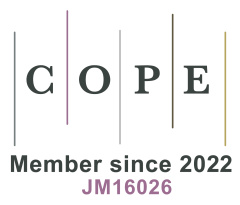Analyzing the mechanism of excess control on digital transformation using biomechanical modeling
Abstract
In order to explore the impact of over-control on the digital transformation of enterprises, the constraints of over-control on digital transformation are analyzed based on a biomechanical model using Chinese A-share listed private enterprises as an example. A number of private enterprises between 2014 and 2023 were selected as the research subjects. After excluding financial institutions, ST companies and samples with incomplete data, a dataset of 1517 firms and 10,388 firm-year observations was finally retained. The results show that excessive control affects the innovation decisions of enterprises to a certain extent and reduces the effectiveness of enterprise digital transformation. When controlling shareholders or de facto controllers’ control exceeds their shareholding, they tend to intervene excessively in enterprises’ technological research and development and digitalization investment, leading to inefficient resource allocation and slowing down the transformation process. In addition, the imperfect corporate governance structure and excessive concentration of power also exacerbate the risks in the process of enterprise digital transformation. To mitigate the negative effects of excess control, enterprises should implement dual-level governance optimization: (1) Establish ownership-cash flow alignment mechanisms such as sunset clauses or shareholding caps to prevent long-term entrenchment; (2) enhance board independence through increased representation of external directors and the formation of digital oversight committees. These measures can reduce the CFi index and increase transparency (ITC), thereby improving transformation efficiency. Moreover, embedding data governance frameworks into digital strategy development can counterbalance centralized control by ensuring stakeholder-informed decision-making. In simple terms, our model shows that when a small number of decision-makers control too much power, it can “choke” the organization’s ability to share resources and adapt to digital changes, much like how an overly tense muscle restricts movement in a biomechanical system.
References
1. Chen S, Cai J, Bogatyreva K, et al. Digital transformation of SMEs in times of uncertainty: effectuation perspective. Journal of Entrepreneurship in Emerging Economies. 2024; 17(2): 483-506. doi: 10.1108/jeee-11-2023-0490
2. Ghobakhloo M, Iranmanesh M, Foroughi B, et al. Industry 4.0 digital transformation and opportunities for supply chain resilience: a comprehensive review and a strategic roadmap. Production Planning & Control. 2023; 36(1): 61-91. doi: 10.1080/09537287.2023.2252376
3. Zhang M, Pu H, Yu T, et al. Digital transformation, management efficiency and excess employees − evidence from Chinese listed firms. Chinese Management Studies. 2024; 19(2): 440-460. doi: 10.1108/cms-09-2023-0476
4. Shan H, Ko D, Wang L, et al. Managerial ability, digital transformation and innovation efficiency: empirical evidence from Chinese manufacturing listed companies. Chinese Management Studies. 2024; 19(2): 526-548. doi: 10.1108/cms-07-2022-0244
5. Yang Z, Su CW, Liu W, et al. Social insurance contribution and firms’ digital transformation: Evidence from China. Applied Economics. 2024; 57(5): 507-524. doi: 10.1080/00036846.2024.2305164
6. Yin S, Zhao Y. An agent-based evolutionary system model of the transformation from building material industry (BMI) to green intelligent BMI under supply chain management. Humanities and Social Sciences Communications. 2024; 11(1). doi: 10.1057/s41599-024-02988-5
7. Song J, Xie Y, Zhang J. Dynamic Equilibrium Between Equity Control and Residual Control: Impact on Corporate Fraud and Innovation. Emerging Markets Finance and Trade. 2024; 61(2): 370-391. doi: 10.1080/1540496x.2024.2330448
8. Zhai H, Yang F, Gao F, et al. Digital Transformation and Over-Investment: Exploring the Role of Rational Decision-Making and Resource Surplus in the Knowledge Economy. Journal of the Knowledge Economy. 2023; 15(3): 14103-14134. doi: 10.1007/s13132-023-01569-2
9. Wu Y, Li H, Luo R, et al. How digital transformation helps enterprises achieve high-quality development? Empirical evidence from Chinese listed companies. European Journal of Innovation Management. 2023; 27(8): 2753-2779. doi: 10.1108/ejim-11-2022-0610
10. Wang L, Hou S. The impact of digital transformation and earnings management on ESG performance: evidence from Chinese listed enterprises. Scientific Reports. 2024; 14(1). doi: 10.1038/s41598-023-48636-x
11. He J, Du X, Tu W. Can corporate digital transformation alleviate financing constraints? Applied Economics. 2023; 56(20): 2434-2450. doi: 10.1080/00036846.2023.2187037
12. Jia X, Xie B, Wang X. The impact of network infrastructure on enterprise digital transformation ——A quasi-natural experiment from the “broadband China” Strategy. Applied Economics. 2023; 56(12): 1363-1380. doi: 10.1080/00036846.2023.2176450
13. Bründl P, Stoidner M, Nguyen HG, et al. Optimizing Intralogistics in an Engineer-to-Order Enterprise with Job Shop Production: A Case Study of the Control Cabinet Manufacturing. SAE International Journal of Materials and Manufacturing. 2024; 17(1). doi: 10.4271/05-17-01-0006
14. Song Y, Wu R. The Impact of Financial Enterprises’ Excessive Financialization Risk Assessment for Risk Control based on Data Mining and Machine Learning. Computational Economics. 2021; 60(4): 1245-1267. doi: 10.1007/s10614-021-10135-4
15. Wang P, Bu H, Liu F. Internal Control and Enterprise Green Innovation. Energies. 2022; 15(6): 2193. doi: 10.3390/en15062193
Copyright (c) 2025 Author(s)

This work is licensed under a Creative Commons Attribution 4.0 International License.
Copyright on all articles published in this journal is retained by the author(s), while the author(s) grant the publisher as the original publisher to publish the article.
Articles published in this journal are licensed under a Creative Commons Attribution 4.0 International, which means they can be shared, adapted and distributed provided that the original published version is cited.



 Submit a Paper
Submit a Paper
